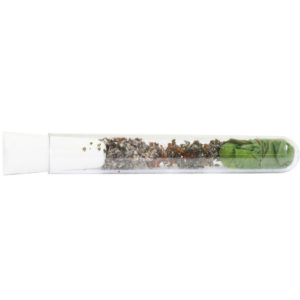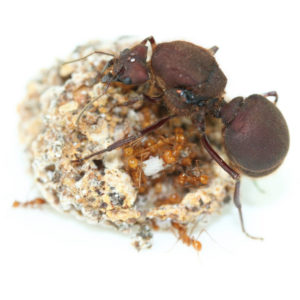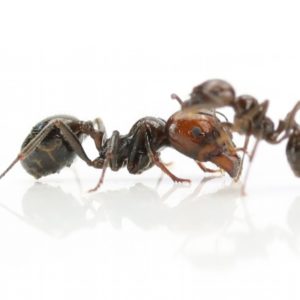Rhytidoponera aspersa (queen)
99,00€
Primitive and endemic species of Australia with a metallic coloring! Fertilized queen for sale to found your colony of green-headed ants!
Out of stock
Description
Rhytidoponera aspersa benefits from the Ant Farming Charter on our Ants:
1. Breeding approved by the Veterinary Services, led by a specialist with a certificate of competence,
2. Perfect Ant Farmer's Guide offered and satin sheet provided,
3. Ants guaranteed free of parasites,
4. Queen fertilized guaranteed,
5. No “boost” (adding brood or external workers to sell the colonies faster),
6. Guaranteed delivery in good health: partial reimbursement in the event of loss of workers, total in the event of loss of the queen (if delivered within 48 hours),
8. Species present in Australia, non-invasive and not threatened,
9. Colony taken back and costs covered if you wish to part with it (see conditions).
______________________________________________________________________________________________
Queens guaranteed fertilized, ready to lay (currently without brood for the most part because freshly collected). Place at 27°C upon receipt for laying.
Very pretty species endemic to Australia, with a metallic coloring, similar to metallica! Very atypical. Also called Green-headed Ant.
Rhytidoponera aspersa are common ants in both natural and urban habitats, being abundant in a wide range of situations.
Warning: able to sting.
Rhytidoponera aspersa is a great seed disperser. It disperses between 43% and 97% of seeds (Beaumont et al. 2011, 2013), transports seeds over greater distances than other ant species, promotes greater seed dispersal through seed redispersion processes ( Beaumont et al. 2013) and bury a large part of the seeds in a potential germination zone. This species therefore feeds on seeds, insects and sweet liquids. She is often nomadic and can move her nest.
These ants measure between 5 and 7 mm. Queens and workers look alike, differing only in size, with males being the smallest. They are well known for their characteristic metallic appearance, which varies from green to purple, even red-violet. Among the most common insects in Australia, green-headed ants are present in almost all Australian states, but are absent in Tasmania. They have also been introduced to New Zealand, where several populations have been established.
This species lives in many habitats, including deserts, forests, woodlands, and urban areas. It nests underground, under logs, stones, twigs and shrubs, or in decaying wood stumps, and is sometimes found living in termite mounds. They are among the first insects to be found in burnt areas after the embers have stopped smoldering. Rain poses no threat to colonies as long as it is a light shower in full sun. The green-headed ant is diurnal, active all day, attacking arthropods and small insects or collecting sweet substances such as honeydew from sap-sucking insects.
Green-headed ants are gamergates, meaning they can breed with winged males. With workers taking on the role of reproductives, queens are relatively insignificant and are rarely produced in colonies. The nuptial flight begins in the spring, with the males mating with one or two females. Queens that establish their own colonies are semi-cloistered, coming out and foraging to support their young. Remember to feed the queens during the foundation of the colony! Another way of forming colonies is budding, where a subset of the colony leaves the main colony for another nesting site. The green-headed ant is known for its painful and poisonous sting which can cause anaphylactic shock in susceptible humans. However, they can also be beneficial to humans, acting as a form of pest control by attacking agricultural pests such as beetles, moths and termites.
You must be logged in to post a review.






Notice
There are no reviews yet.